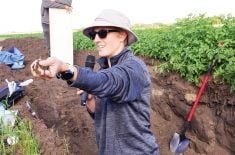Researchers often advise producers to apply sulfur annually because the nutrient’s availability to canola is difficult to understand and varies from year to year.
However, that hasn’t stopped Manitoba growers from experimenting with variable rates of sulfur.
Arthur Bell of Boissevain, Man., is one of them.
For the last several years, he has applied different amounts of sulfur to different agronomic zones in his canola fields.
He varies his sulfur application from zero to 50 pounds per acre, depending on topography, soil tests and yield goals.
Read Also

Soybean market still figuring out implications of China-U.S. pact
Soybean futures had a muted reaction to the U.S. trade deal with China as the market tries to figure out the nuances of the deal.
Bell grows his canola on rolling fields where soil tests show sulfur is generally sufficient in low-lying areas and deficient on hilltops. He is mainly interested in the land between those extremes.
“It’s probably the mid-slopes that have the best potential (for yield gains),” said Bell, who grows canola, wheat, oats, sunflowers and rye.
Bell said he has increased canola yields in the mid-slopes by five to 10 bushels per acre by applying a fertilizer blend higher in sulfur.
However, he admitted it’s hard to know if better sulfur management deserves all the credit.
“It’s very hard to nail it down to just one particular product because it’s an integrated approach with nitrogen and phosphate,” he said.
“We can’t accord all the benefits to sulfur alone.”
Bell provides a specific fertilizer blend for each part of the field, based on knowledge gained from yield maps and soil tests.
“By doing all the products … I believe variable rate is much more advantageous to just doing nitrogen,” he said.
“Most savings are in phosphate, potash and sulfur than they are in nitrogen alone…. With this approach you’re getting a proper fertilizer blend, a separate blend, for each zone. I think of it as each zone is treated as a separate field.”
Kory Van Damme, a territory manager for Farmers Edge in Manitoba’s Pembina Valley, said some farmers are skeptical about variable rates and sulfur, but the skepticism is waning.
“People have always said that sulfur was different within a foot…. I don’t really believe that,” he said.
“The sulfur (level) more or less follows the topography of the land. On your knolls and your sandier ground, the sulfur is a lot lower. As you get into the lower lying areas, sulfur goes way up.”
He said more farmers are now telling companies such as his to add sulfur to the variable rate package.
“Some growers come to us and say we’ll get into full out variable rate: P, K, S and everything. When we do the S, they just say do your thing.”
John Heard, soil fertility specialist with Manitoba Agriculture, said it doesn’t surprise him that farmers are trying variable rate with sulfur because it has been known for a while that the nutrient is abundant in the lower elevations of a field.
As a result, it may be time to move beyond thinking of sulfur as an insurance policy, where 20 to 30 lb. of sulfur are added to every acre of canola as a precaution.
However, he said producers who reduce the nutrient in part of a field will need to monitor the crop closely for signs of sulfur deficiency.
“That’s what I always say. Whenever you drop a nutrient from your fertility program, you substitute those cost savings with increased crop scouting.”















